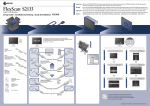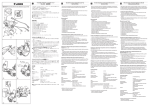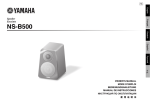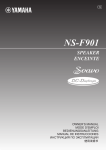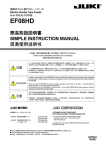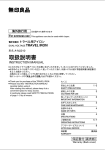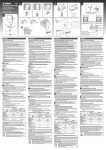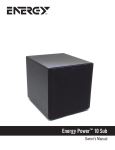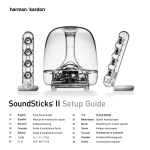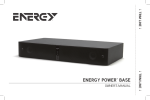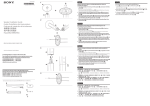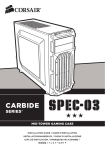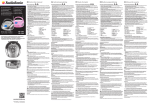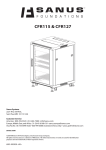Download manual de instrucciones
Transcript
RTL (NS-B40 + NS-C40 + NS-SW40) SPEAKER PACKAGE OWNER'S MANUAL MANUAL DE INSTRUCCIONES Precautions 1. To assure the finest performance, please read this manual carefully. Keep it in a safe place for future reference. 2. Install the speakers in a cool, dry, clean place – away from windows, sources of heat, sources of excessive vibration, dust, moisture or cold. Avoid sources of electrical humming (e.g., transformers and motors). To prevent fire or electric shock, do not expose the speakers to rain or water. 3. To prevent the enclosure from warping or discoloring, do not expose the speakers to direct sunlight or excessive humidity. 4. Avoid installing the speakers where foreign objects may fall onto them and/or where they may be exposed to liquid dripping or splashing. 5. Do not place the following objects on top of the speakers: – Other components, as they might damage or discolor the surface of the speakers. – Burning objects (e.g., candles), as they might cause fire, damage to the speakers or personal injury. – Containers of liquid, as they might spill and cause electric shock to the user or damage to the speakers. 6. Do not place the speakers where they are liable to be knocked over or struck by falling objects. Stable placement will also ensure better sound performance. 7. Placing the speakers on the same shelf or rack as the turntable can result in feedback. 8. Any time you note distortion, reduce the volume control on your amplifier to lower setting. Never allow your amplifier to be driven into “clipping”. Otherwise, the speakers may be damaged. 9. When using an amplifier with a rated output power higher than the nominal input power of the speakers, care should be taken not to exceed the maximum input of the speakers. 10. Do not attempt to clean the speakers with chemical solvents as this might damage the finish. Use a clean, dry cloth. 11. Do not attempt to modify or fix the speakers. Contact qualified Yamaha service personnel when service is needed. The cabinet should never be opened for any reason. 12. Be sure to read the “Troubleshooting” section regarding common operating errors before concluding that the speakers are faulty. 13. Secure placement or installation is the owner’s responsibility. Yamaha is not liable for accidents caused by improper placement or installation of speakers. For NS-SW40 WARNING TO REDUCE THE RISK OF FIRE OR ELECTRIC SHOCK, DO NOT EXPOSE THIS APPLIANCE TO RAIN OR MOISTURE. 1. Do not operate this unit upside down. It may overheat, possibly causing damage. 2. Do not use excessive force on switches, controls or connection wires. When moving this unit, first disconnect the power plug and the wires connected to other equipment. Never pull the wires themselves. 3. Never put a hand or a foreign object into the port located on the right side of this unit. When moving this unit, do not hold the port, as it might cause personal injury and/or damage to this unit. 4. Since this unit has a built-in power amplifier, heat radiates from the rear panel. Place the unit away from walls, allowing at least 20 cm (8") of space above, behind and on both sides of the unit to prevent fire or damage. Furthermore, do not position the unit with the rear panel facing down on the floor or other surfaces. 5. When using a humidifier, be sure to avoid condensation inside this unit by allowing enough space around the unit and avoiding excess humidification. Condensation might cause fire, damage to the unit, and/or electric shock. 6. Do not cover the rear panel of this unit with a newspaper, tablecloth, curtain, etc. to avoid obstructing heat radiation. If the temperature inside the unit rises, it may cause fire, damage to the unit, or personal injury. 7. Do not plug this unit into a wall outlet until all connections are complete. 8. The voltage to be used must match that specified on the rear panel. Using this unit with a voltage higher than specified is dangerous and may cause fire, damage to the unit, and/or personal injury. Yamaha is not responsible for damage resulting from use of this unit with a voltage other than specified. 9. Super-bass sound reproduced by this unit may cause a turntable to generate audio feedback. In this case, move the unit away from the turntable. 10. This unit may be damaged if certain sounds are continuously output at high volume level. For example, if 20 Hz–50 Hz sine waves from a test disc or bass sounds from an electronic instrument, etc. are continuously output, or if a turntable stylus touches the surface of a disc, reduce the volume level to prevent the unit from being damaged. 11. If you hear distorted noise (i.e., unnatural, intermittent “rapping” or “hammering” sounds) from this unit, reduce the volume level. Extremely loud movie soundtrack low frequency, bass-heavy sounds, or similarly loud popular music passages can damage this unit. 12. Vibration generated by super-bass sound may distort images on a TV. In this case, move the unit away from the TV set. 13. When disconnecting the power cord from the wall outlet, grasp the plug; do not pull the cord. 14. When you plan not to use this unit for a long period of time (i.e. vacation, etc.), disconnect the AC power plug from the wall outlet. 15. Install this unit near the wall outlet and where the AC power plug can be reached easily. i En English Please read the following operating precautions before use. Yamaha will not be held responsible for any damage and/or injury caused by not following the cautions below. Precautions • VOLTAGE SELECTOR (For China, Asia and General models) The voltage selector switch on the rear panel of this unit must be set to your local main voltage BEFORE plugging this unit into the AC main supply. Voltages are 110-120/220-240 V AC, 50/60 Hz. This unit is not disconnected from the AC power source as long as it is connected to the wall outlet, even if this unit itself is turned off. In this state, this unit is designed to consume a very small quantity of power. For U.K. customers If the socket outlets in the home are not suitable for the plug supplied with this appliance, it should be cut off and an appropriate 3 pin plug fitted. For details, refer to the instructions described below. Note: The plug severed from the mains lead must be destroyed, as a plug with bared flexible cord is hazardous if engaged in a live socket outlet. SPECIAL INSTRUCTIONS FOR U.K. MODEL IMPORTANT: THE WIRES IN MAINS LEAD ARE COLOURED IN ACCORDANCE WITH THE FOLLOWING CODE: Blue: NEUTRAL Brown: LIVE As the colours of the wires in the mains lead of this apparatus may not correspond with the coloured markings identifying the terminals in your plug, proceed as follows: The wire which is coloured BLUE must be connected to the terminal which is marked with the letter N or coloured BLACK. The wire which is coloured BROWN must be connected to the terminal which is marked with the letter L or coloured RED. Make sure that neither wire is connected to the earth terminal of a three pin plug. For Canadian Customers To prevent electric shock, match wide blade of plug to wide slot and fully insert. This Class B digital apparatus complies with Canadian ICES-003. ii En Contents Connecting the speakers .................................. 3 Connection diagram.............................................3 Connecting the power cables ..............................4 Using the Subwoofer ......................................... 4 Setting the subwoofer volume .............................4 Troubleshooting ................................................. 5 Specifications...................................................... 6 Package contents Make sure the package contains the following items. Subwoofer (NS-SW40) x1 Subwoofer cable 5 m (16 ft.) x1 Front and surround speakers (NS-B40) x4 Non-skid pad Center speaker (NS-C40) x1 Speaker cable 24.5 m (80 ft.) x1 (To be cut into 5 lengths for the front, center, and surround speakers. Take care to prevent injury when preparing the cables.) Non-skid pads: When placing the speakers on a flat surface, affix the included non-skid pads to the corners of the speaker undersides, as shown. The pads will prevent the speaker from moving around. Non-skid pads (24 pcs.) x1 (For the front, center and surround speakers. Including 4 spare non-skid pads.) Installing the speakers Before you connect the speakers, place each speaker in its respective location. Speaker positioning is very important as it affects the overall sound quality of the system. Place the speakers in locations that will optimize the sound quality at your listening position. Refer to the illustration. • Center Subwoofer The position of the subwoofer is not as critical as the position of the other speakers because sub-bass sounds are not very directional. Refer to “Installing the subwoofer” on page 2 for more information. Note • Placing the speakers too close to a CRT-type TV may impair the picture color or cause a buzzing noise. In this case, move the speakers at least 20 cm (8") away from the TV. This is not an issue with LCD and plasma TVs. Front right Front left Surround left Surround right 1 En English Package contents................................................1 Installing the speakers.......................................1 Installing the front, center, and surround speakers ...........................................................2 Installing the subwoofer.......................................2 Wall-mounting the speakers................................2 Installing the speakers Installing the front, center, and surround speakers Front speakers: Place the two front speakers on the left and right sides of the TV facing directly forward. Surround speakers: Place the left and right surround speakers behind your listening position, facing slightly inward. The front and surround speakers can be placed on a flat surface or wall- mounted. See “Wall-mounting the speakers” for more information. Center speaker: Place the center speaker centrally between the front speakers, facing directly forward. Wall-mounting the speakers You can mount the speakers on the wall as follows. 1 2 Install screws into a solid wall or wall support as shown below. Use 3.5 to 4 mm (1/8") diameter self-tapping screws. Hang each speaker by its keyhole slots onto the protruding screws. Note • Make sure the shaft of the screw is seated in the narrow part of the keyhole slot. Otherwise, the speaker may fall. Wall/wall support NS-B40 Installing the subwoofer Place the subwoofer on the outside of either the right or the left front speaker, as shown in A and B. A 6 mm (1/4") Minimum 20 mm (3/4") B 150 mm (5-7/8") NS-C40 Warnings C Note: Standing waves may make it difficult to hear bass sounds here. Subwoofer Front speaker The placement shown in C is also possible, however, if the subwoofer is placed directly facing a wall and your listening position is in the center of the room, you may not be able to obtain enough bass sound from the subwoofer. This is because “standing waves” are forming between the two parallel walls and cancelling out the bass sounds. In this case, position the subwoofer at an angle to the wall. It may be necessary to break up parallel wall surfaces by placing bookshelves, etc., along them. 2 En • NS-B40 speaker weighs 0.59 kg (1.30 lbs.) and NSC40 speaker weighs 0.73 kg (1.61 lbs.). Do not mount the speakers on thin plywood or on a wall with a soft surface material. Otherwise, the screws may pull out of the surface and the speakers may fall, possibly damaging the speakers or causing personal injury. • Do not affix the speakers to a wall using nails, adhesives, or unstable hardware. Long-term use and vibration may cause the speakers to fall. • To avoid accidents resulting from tripping over loose speaker cables, affix the cables to the wall. • Mount the speakers in a wall location that will be unlikely to result in injury to an individual’s head. Connecting the speakers Connection diagram Surround speakers Right Left Center speaker SPEAKERS FRONT SURROUND CENTER Amplifier DOCK ANTENNA (BD/DVD) HDMI OUT HDMI 2 HDMI 1 HDMI 3 HDMI 4 FM GND AM COMPONENT VIDEO PR PR PB PB 75 SPEAKERS FRONT SURROUND Y SUBWOOFER MONITOR OUT Y COMPONENT VIDEO OPTICAL AV 1 Subwoofer To AC wall outlet Once you’ve positioned the speakers, you’ll need to cut the 24.5-meter (80 ft.) speaker cable to make five cables for connecting the two front speakers, center speaker, and the two surround speakers. 2 AV 2 COAXIAL OPTICAL (CD) ( TV ) AV 3 AV 4 AV 5 AV OUT AUDIO 1 AUDIO 2 AUDIO OUT SUBWOOFER Note: The exact layout of the speaker terminals depends on your amplifier. ■ Preparing the speaker cables 1 COAXIAL CENTER MONITOR OUT VIDEO Cut the included speaker cable to suitable lengths for the front, center, and surround speakers. You need five cables. Remove about 10 mm (3/8") of insulation from the end of each speaker cable. Right 3 Front speakers Left Twist the bare wires tightly. 10 mm (3/8") Good No Good Notes • Make the speaker cables as short as possible. Do not bundle or roll up excess cable. • Twist the bare wires tightly so the individual strands are not splayed. • Be careful not to injure yourself while preparing the speaker cables. 3 En English Caution: Make sure the power cables for the subwoofer and your other AV components are disconnected from the AC wall outlets before making any connections. ■ Operating the speaker terminals Negative (–) Positive (+) 1 3 1 2 3 4 2 Note: Make sure the terminal is gripping the bare wire, not the insulation. Press and hold the terminal tab. ■ Connecting the speakers Connect each speaker to the appropriate speaker terminals on your amplifier by using the cables you prepared earlier. See the “Connection diagram” on page 3 for reference. Make sure you connect the speakers with the correct polarity—positive (+) terminals to positive (+) terminals, and negative (–) terminals to negative (–) terminals. If you get them crossed over, the sound will be unnatural and lack bass. In your AV receiver’s speaker size settings, specify small (or “S”) for all of the NS-P40 speakers. Insert the bare wire. Release the tab so that it closes securely on the bare wire, not the insulation. Test the security of the connection by pulling gently on the cable. Notes • Make sure the bare wires do not touch each other, as this could damage the speaker or the amplifier. • If the connections are faulty, you will hear no sound from the speakers. If you’re connecting the subwoofer to a Yamaha DSP amplifier or AV receiver, connect to its SUBWOOFER or LOW PASS output. Connecting the power cables Once you’ve completed all of the speaker and subwoofer connections, plug the subwoofer, amplifier, and your other AV components into suitable AC wall outlets. Using the Subwoofer 4 POWER switch Set this to ON to turn on the subwoofer. Set it to OFF to turn off the subwoofer. 5 VOLTAGE SELECTOR (China, Asia, and General models) Make sure the VOLTAGE SELECTOR is set to the correct voltage for your area (110–120/220–240 V AC, 50/60 Hz). Ask your dealer if you are not sure. Warning Disconnect the power cable before changing the VOLTAGE SELECTOR setting. Setting the subwoofer volume Rear panel 1 Power indicator Lights up when the POWER switch is set to ON; goes off when the POWER switch is set to OFF. 2 INPUT jack Input jack for connecting the line-level subwoofer output on your amplifier. The very first time you use the subwoofer, you need to set the volume balance between the subwoofer and the front speakers as follows. 1 2 3 4 3 VOLUME control Adjusts the volume of the subwoofer. Turn it clockwise to increase the volume; counterclockwise to decrease the volume. 4 En 5 Turn on your other AV components. Set the subwoofer’s VOLUME control to minimum (0). Set the subwoofer’s POWER switch to ON. The power indicator on the rear panel lights up. Play a audio source that contains lowfrequency bass sounds. Set the amplifier’s volume control to a suitable level. Turn the subwoofer’s VOLUME control up gradually until you achieve a good balance between the subwoofer and the other speakers. • If you replace the front speakers (NS-B40) with other speakers, you will need to re-adjust the subwoofer’s volume. Troubleshooting If this product doesn’t work as expected, look for a possible cause below. If the issue you are experiencing is not listed, or you cannot resolve it after reading through these instructions, disconnect the power cable and contact an authorized Yamaha dealer or service center. ■ Front, surround speakers (NS-B40) and center speaker (NS-C40) Issue Possible cause Remedy There’s no sound. The speaker cables are not connected properly. Make sure the speaker cables are connected properly. The sound is very quiet. The speaker cables are not connected properly. Make sure the speaker cables are connected properly: L (left) to L, R (right) to R, “+” to “+” and “–” to “–”. ■ Subwoofer (NS-SW40) Issue Possible cause Remedy The POWER switch is set to ON but the subwoofer doesn’t work. The power cable is not connected Set the POWER switch to OFF, then make sure the power properly. cable is connected properly. There’s no sound. The VOLUME control is set to 0. Turn up the VOLUME control. The subwoofer is too quiet. The subwoofer cable is not connected properly. Make sure the subwoofer cable is connected properly. The source material doesn’t contain much bass. Try playing source material that contains more bass. Bass sounds are being cancelled out by standing waves. Reposition the subwoofer, or break up parallel wall surfaces by placing bookshelves or other large objects along the wall. 5 En English Notes • Once the subwoofer volume has been set, you can leave the subwoofer’s VOLUME control set as it is and use your amplifier’s volume control to adjust the volume of the entire system. Specifications ■ Front, surround speakers (NS-B40) and center speaker (NS-C40) Type NS-B40 ................................................... Full range bass reflex non magnetic shielding type NS-C40...................................Full range acoustic suspension non magnetic shielding type Driver ...................................................7 cm (2-3/4") cone type Nominal input power ....................................................... 30 W Maximum input power .................................................. 100 W Impedance ............................................................................. 6 Ω Frequency response NS-B40 .............................................. 50 Hz–25 kHz (–10 dB) –45 kHz (–30 dB) NS-C40.............................................. 70 Hz–25 kHz (–10 dB) –45 kHz (–30 dB) Sensitivity NS-B40 .........................................................83 dB/2.83 V, 1 m NS-C40.........................................................84 dB/2.83 V, 1 m Dimensions (W x H x D) NS-B40 ........ 112 x 176 x 116 mm (4-3/8" x 6-7/8" x 4-5/8") NS-C40...........276 x 111 x 118 mm (10-7/8" x 4-3/8" x 4-5/8") Weight NS-B40 ......................................................... 0.59 kg (1.30 lbs.) NS-C40......................................................... 0.73 kg (1.61 lbs.) 6 En ■ Subwoofer (NS-SW40) Type ..............Advanced Yamaha Active Servo Technology II Driver ............................................16 cm (6-1/2") cone woofer non magnetic shielding type Amp output power.............. 50 W (100 Hz, 5 Ω, 10% T.H.D) Amp dynamic power .............................................. 100 W, 5 Ω Input impedance .................INPUT (1P RCA pin jack): 12 kΩ Frequency response ...........................................30 Hz–200 Hz Input sensitivity............................INPUT (1P RCA pin jack): 50 mV (50 Hz, 50 W/5 Ω) Power supply U.S.A. and Canada models ..........................AC 120 V, 60 Hz Australia model.............................................AC 240 V, 50 Hz U.K. and Europe models..............................AC 230 V, 50 Hz China, Asia, and General models ........... AC 110–120/220–240 V, 50/60 Hz Dimensions (W x H x D) .......................290 x 292 x 327 mm (11-3/8" x 11-1/2" x 12-7/8") Weight .............................................................. 8.0 kg (17.6 lbs.) Specifications are subject to change without notice. Precauciones Lea las siguientes precauciones de funcionamiento antes de iniciar el uso del aparato. Yamaha no se responsabilizará de cualquier daño o lesión causada por no seguir las precauciones que aparecen a continuación. Para el NS-SW40 ADVERTENCIA PARA REDUCIR EL RIESGO DE INCENDIO Y DESCARGA ELÉCTRICA, NO EXPONGA ESTA UNIDAD A LA LLUVIA O A LA HUMEDAD. 1. No utilice esta unidad al revés. Puede recalentarse y dañarse. 2. No utilice demasiada fuerza con los conmutadores, controles o cables de conexión. Cuando traslade esta unidad, desconecte primero la clavija de alimentación y los cables conectados a otro equipo. No tire nunca de los cables. 3. Nunca ponga las manos o un objeto extraño en el puerto, situado a la derecha de esta unidad. Cuando mueva la unidad, no toque el puerto, ya que podría causar lesiones personales o la unidad podría averiarse. 4. Como esta unidad tiene un amplificador de potencia incorporado sale calor del panel trasero. Aleje la unidad de las paredes, dejando un espacio mínimo de 20 cm por encima, por detrás y a ambos lados de launidad para evitar que se produzca un incendio o daños. Además, no ponga la unidad con el panel trasero hacia abajo en el suelo o en otras superficies. 5. Cuando utilice un humidificador, asegúrese de evitar la condensación dentro de esta unidad dejando un espacio suficiente alrededor de la misma y evitando el exceso de humidificación. La condensación puede causar un incendio, daños en la unidad y/o descargas eléctricas. 6. No tape el panel trasero de esta unidad con un periódico, mantel, cortina, etc. para evitar obstruir la salida del calor. Si sube la temperatura dentro de la unidad se puede producir un incendio que dañará la unidad o causará lesiones a personas. 7. No enchufe esta unidad a una toma de corriente hasta terminar todas las demás conexiones. 8. La tensión que se utilice deberá ser la indicada en el panel trasero. Utilizar esta unidad con una tensión superior a la especificada es peligroso y puede causar un incendido, daños en la unidad y/o lesiones a personas. Yamaha no es responsable de los daños debido a la utilización de esta unidad con una tensión diferente de la especificada. 9. El sonido superbajos reproducidos por esta unidad pueden hacer que el giradiscos genere realimentación de audio. En este caso, separe la unidad del giradiscos. 10. Esta unidad se puede dañar si hay ciertos sonidos que salen continuamente con un nivel alto. Por ejemplo, si las ondas sinusoidales de 20 Hz–50 Hz de un disco de prueba o de los sonidos graves de un instrumento electrónico, etc. salen continuamente, o si la aguja del giradiscos toca la superficie del disco, reduzca el volumen para impedir que se dañe la unidad. 11. Si oye sonido distorsionado (es decir, sonido de “golpeteo” o “martilleo” no natural o intermitente, reduzca el nivel del sonido. Las frecuencias bajas de las pistas de sonido de películas demasiado altas, los sonidos de graves fuertes o los pasajes de música popular demasiado altos pueden dañar esta unidad. i Es Español 1. Para asegurar el mejor rendimiento posible, lea con atención este manual. Guárdelo en un lugar seguro para consultarlo en el futuro. 2. Instale los altavoces en un lugar fresco, seco y limpio: alejados de ventanas, fuentes de calor, fuentes de vibraciones excesivas, polvo, humedad o frío. Evite fuentes de zumbido eléctrico (transformadores y motores por ejemplo). Para impedir incendios o descargas eléctricas, no exponga los altavoces a la lluvia o al agua. 3. Para impedir que las cajas se deformen o pierdan color, no exponga los altavoces a la luz solar directa o a una humedad excesiva. 4. Evite instalar los altavoces donde puedan caer sobre ellos objetos extraños, y/o donde puedan estar expuestos al goteo o salpicadura de líquidos. 5. No ponga los objetos siguientes encima de los altavoces: – Otros componentes, porque pueden dañar o descolorar la superficie de los altavoces. – Objetos con fuego (velas por ejemplo) porque pueden causar un incendio, daños en los altavoces o lesiones a las personas. – Recipientes de líquidos, porque pueden derramar su contenido y dar descargas eléctricas al usuario o dañar los altavoces. 6. No ponga los altavoces donde puedan ser tirados o golpeados por objetos que se caen. Los lugares estables garantizan un mejor sonido. 7. Poner los altavoces en la misma estantería que un giradiscos puede causar realimentación. 8. Si nota distorsión, reduzca el volumen en su amplificador. No haga funcionar su amplificador al límite de “amplitud”. De lo contrario, los altavoces podrían dañarse. 9. Cuando utilice un amplificador con una potencia nominal de salida superior a la potencia nominal de entrada de los altavoces, deberá tenerse cuidado para no superar la entrada máxima de los altavoces. 10. No limpie los altavoces con disolventes químicos porque podría dañar el acabado. Utilice un paño limpio y seco. 11. No intente modificar o arreglar los altavoces. Póngase en contacto con el personal de servicio de Yamaha cuando necesite hacer reparaciones. No abra la caja bajo ninguna circunstancia. 12. Lea la sección “Solucionar problemas” para conocer los errores de funcionamiento más comunes antes de concluir que los altavoces tienen defectos. 13. El propietario es el responsable de que la colocación o la instalación sean seguras. Yamaha no se hace responsable de los accidentes debidos a una mala colocación o instalación de los altavoces. Precauciones 12. La vibración generada por el sonido superbajo puede distorsionar la imagen de un televisor. En este caso, separe la unidad del televisor. 13. Cuando desconecte el cable de alimentación de la toma de corriente, sujete la clavija; no tire del cable. 14. Cuando no piense utilizar esta unidad durante mucho tiempo (en vacaciones, etc.) desconecte el cable de alimentación de CA de la toma de corriente. 15. Instale esta unidad cerca de la toma de CA, donde se pueda llegar fácilmente a la clavija de alimentación de CA. • VOLTAGE SELECTOR (Pera modelos en China, Asia y modelos generales) El interruptor de selección de tensión situado en el panel trasero de esta unidad debe ajustarse a la tensión principal de su emplazamiento ANTES de enchufar esta unidad a la corriente eléctrica. La selección de voltajes es para CA de 110-120/ 220-240 V a 50/60 Hz. Esta unidad no se desconecta de la fuente de alimentación de CA si está conectada a una toma de corriente, aunque la propia unidad esté apagada. En este estado, la unidad ha sido diseñada para que consuma una cantidad de corriente muy pequeña. ii Es Contenido Conectar los altavoces....................................... 3 Diagrama de conexión .........................................3 Conectar los cables de alimentación ..................4 Utilizar el subwoofer.......................................... 4 Ajustar el volumen del subwoofer.......................4 Solucionar problemas ....................................... 5 Especificaciones.................................................. 6 Contenido del paquete Compruebe que el paquete contiene los siguientes elementos. Subwoofer (NS-SW40) x1 Cable del subwoofer 5 m x1 Altavoces frontales y surround (NS-B40) x4 Taco antideslizante Altavoz central (NS-C40) x1 Cable del altavoz 24,5 m x1 (Debe cortarse en 5 partes para los altavoces frontal, central y surround. Procure no lastimarse cuando prepare los cables.) Tacos antideslizantes: Si coloca los altavoces en una superficie plana, adjunte los tacos antideslizantes incluidos en las esquinas de la parte inferior del altavoz, tal como se muestra a continuación. Los tacos evitarán que el altavoz se desplace. Tacos antideslizantes (24 uds.) x1 (Para los altavoces frontales, central y surround. Incluye 4 tacos antideslizantes de repuesto.) Instalar los altavoces Antes de conectar los altavoces, sitúe cada altavoz en la posición correspondiente. La ubicación de los altavoces es muy importante, ya que afecta a la calidad de sonido global del sistema. Sitúe los altavoces en ubicaciones que optimicen la calidad de sonido en la posición de audición. Consulte la ilustración. La posición del subwoofer no es tan crucial como la posición del resto de los altavoces, ya que los sonidos de subgraves no son muy direccionales. Para más información, consulte “Instalar el subwoofer” de la página 2. Nota • Si sitúa los altavoces demasiado cerca de un televisor TRC, afectaran al color de la imagen o provocarán un zumbido. En ese caso, aleje los altavoces del televisor como mínimo 20 cm. Esto no sucede con los televisores de plasma o LCD. Frontal derecho Frontal izquierdo Central Surround izquierdo Subwoofer Surround derecho 1 Es Español Contenido del paquete......................................1 Instalar los altavoces ..........................................1 Instalar los altavoces frontales, central, y surround ..........................................................2 Instalar el subwoofer.............................................2 Instalar los altavoces en la pared.........................2 Instalar los altavoces Instalar los altavoces frontales, central, y surround Instalar los altavoces en la pared Altavoces frontales: Sitúe los dos altavoces frontales en los lados derecho e izquierdo del televisor totalmente hacia delante. Altavoces Surround: Sitúe los altavoces surround derecho e izquierdo por detrás de la posición de audición, ligeramente hacia dentro. Los altavoces frontales y surround pueden colocarse sobre una superficie plana o fijarlos a una pared. Para más información, consulte “Instalar los altavoces en la pared”. Altavoz central: Sitúe el altavoz central justo entre los altavoces frontales, totalmente hacia delante. 1 Instalar el subwoofer Puede instalar los altavoces en una pared de la manera siguiente. 2 Fije los tornillos a una pared firme o en un soporte para la pared, tal como se muestra a continuación. Utilice tornillos autorroscantes de 3,5 a 4 mm de diámetro. Cuelgue cada altavoz por los orificios en los tornillos que sobresalen. Nota • Compruebe que el extremo del tornillo encaja en la parte estrecha del orificio. De lo contrario, el altavoz podría caer. Pared/soporte para la pared Sitúe el subwoofer fuera del radio de los altavoces frontales izquierdo y derecho, como se muestra en A y B. A NS-B40 6 mm Mínimo 20 mm B 150 mm NS-C40 C Advertencias Nota: Aquí, las ondas estacionarias pueden dificultar la audición de los sonidos graves. Subwoofer Altavoz frontal La disposición que se indica en C también es posible; sin embargo, si el subwoofer se ubica directamente frente a una pared y la posición de audición está en el centro de la habitación, es posible que no obtenga suficiente sonido grave del subwoofer. Esto se debe a que las “ondas estacionarias” se forman entre las dos paredes paralelas y compensan los sonidos graves. En ese caso, coloque el subwoofer en un ángulo de la pared. Es posible que tenga que dividir las superficies de las paredes paralelas, colocando estanterías, etc. en ellas. 2 Es • El altavoz NS-B40 pesa 0,59 kg y el altavoz NS-C40 pesa 0,73 kg. No instale los altavoces en contrachapados de madera fina ni en paredes poco resistentes. Si lo hiciera, los tornillos podrían arrancarse de la superficie, caerse los altavoces y dañarse o provocarle lesiones personales. • No fije los altavoces en una pared utilizando clavos, adhesivos o material poco seguro. La utilización prolongada y las vibraciones podrían causar que los altavoces se cayeran. • Para evitar tropezar con los cables de los altavoces, fíjelos en la pared. • Instale los altavoces en un lugar de la pared donde no puedan alcanzar la cabeza de alguien. Conectar los altavoces Precaución: Antes de realizar las conexiones, compruebe que los cables de alimentación para el subwoofer y los otros componentes AV no estén conectados a las tomas de CA. Diagrama de conexión Español Altavoces Surround Derecho Izquierdo Altavoz central SPEAKERS FRONT SURROUND CENTER Amplificador DOCK ANTENNA (BD/DVD) HDMI OUT HDMI 2 HDMI 1 HDMI 3 HDMI 4 FM GND AM COMPONENT VIDEO PR PR PB PB 75 SPEAKERS FRONT SURROUND Y SUBWOOFER MONITOR OUT Y COMPONENT VIDEO OPTICAL AV 1 Subwoofer A la toma de CA ■ Preparar los cables del altavoz Cuando haya situado los altavoces, corte unos 24,5 metros de cable de altavoz para obtener cinco cables para conectar los dos altavoces frontales, el altavoz central y los dos altavoces surround. 1 2 Corte el cable del altavoz incluido a una longitud adecuada para los altavoces frontales, central y surround. Necesita cinco cables. Pele unos 10 mm del aislamiento del extremo de cada cable del altavoz. COAXIAL AV 2 COAXIAL OPTICAL (CD) ( TV ) AV 3 AV 4 AV 5 AV OUT AUDIO 1 AUDIO 2 AUDIO OUT Derecho Izquierdo Altavoces frontales 3 CENTER MONITOR OUT VIDEO SUBWOOFER Nota: La distribución exacta de los terminales del altavoz depende del amplificador. Retuerza y apriete los cables pelados. 10 mm Correcto Incorrecto Notas • El cable de los altavoces debe ser tan corto como sea posible. No ate ni enrolle los cables excesivamente. • Trence los cables pelados firmemente para que los filamentos individuales no se separen. • Procure no lesionarse cuando prepare los cables de altavoz. 3 Es ■ Utilizar los terminales del altavoz Negativo (–) Positivo (+) 1 3 1 2 3 4 2 Nota: Compruebe que el terminal sujete los cables pelados y no la parte aislada. Mantenga pulsada la lengüeta del terminal. Inserte el cable pelado. Suelte la lengüeta para que sujete correctamente el cable por su extremo pelado, no la parte del aislamiento. Compruebe que la conexión sea segura tirando ligeramente del cable. Notas • Compruebe que los cables pelados no se toquen entre ellos, de lo contrario podrían dañar el altavoz o el amplificador. • Si las conexiones no son correctas, los altavoces no emitirán sonido. ■ Conectar los altavoces Conecte cada altavoz a los terminales de altavoz del amplificador adecuados a través de los cables que ha preparado anteriormente. Para referencia, consulte “Diagrama de conexión” de la página 3. Asegúrese de conectar los altavoces con la polaridad correcta:los terminales positivos (+) a los terminales positivos (+) y los negativos (–) a los terminales negativos (–). Si los cruza, el sonido no será natural y sin graves. En los ajustes de tamaño del receptor AV, especifique pequeño o Small (o “S”) para todos los altavoces del NS-P40. Si conecta el subwoofer a un amplificador DSP de Yamaha o a un receptor AV, conéctelo a su SUBWOOFER o a la salida LOW PASS. Conectar los cables de alimentación Cuando haya terminado de realizar las conexiones del altavoz y el subwoofer, conecte el subwoofer, el amplificador y los otros componentes AV a las tomas de CA correspondientes. Utilizar el subwoofer 4 Conmutador POWER Colóquelo en la posición ON para activar el subwoofer. Colóquelo en la posición OFF para desactivar el subwoofer. 5 VOLTAGE SELECTOR (Pera modelos en China, Asia y modelos generales) Compruebe que el VOLTAGE SELECTOR está ajustado al voltaje correcto de su zona (CA de 110–120/220–240 V a 50/60 Hz). Si no está seguro, consulte a su distribuidor. Advertencia Desconecte el cable de alimentación antes de cambiar el ajuste del VOLTAGE SELECTOR. Ajustar el volumen del subwoofer Panel posterior 1 Indicador Power Se ilumina al ajustar el conmutador POWER a ON; se apaga al ajustar el conmutador POWER a OFF. 2 Jack INPUT Jack de entrada para conectar el subwoofer de nivel de línea en el amplificador. 3 Control VOLUME Ajusta el volumen del subwoofer. Gírelo en sentido horario para subir el volumen y en sentido antihorario para bajarlo. 4 Es La primera vez que utilice el subwoofer, deberá ajustar el balance de volumen entre éste y los altavoces delanteros, de la manera siguiente. 1 2 3 Active el resto de los componentes AV. Ajuste al mínimo (0) el control VOLUME del subwoofer. Coloque el conmutador POWER del subwoofer en la posición ON. Se ilumina el indicador de alimentación del panel posterior. 4 5 Reproduzca una fuente de audio que contenga sonidos graves de baja frecuencia. Coloque el control de volumen del amplificador a un nivel adecuado. Suba gradualmente el control VOLUME del subwoofer hasta que consiga un buen balance entre el subwoofer y los otros altavoces. Solucionar problemas Si este producto no funciona de la forma deseada, a continuación encontrará una lista con las posibles causas. Si el problema surgido no aparece en la lista, o bien si no puede solucionarlo después de leer estas instrucciones, desconecte el cable de alimentación y consulte con un centro de servicio o con un distribuidor Yamaha autorizado. ■ Altavoces frontales, surround (NS-B40), y central (NS-C40) Problema Posible causa Solución No hay sonido. Los cables del altavoz no están conectados correctamente. Compruebe que los cables de los altavoces estén conectados correctamente. El sonido es muy bajo. Los cables del altavoz no están conectados correctamente. Compruebe que los cables de los altavoces estén conectados correctamente: L (izquierdo) a L, R (derecho) a R, “+” a “+” y “–” a “–”. ■ Subwoofer (NS-SW40) Problema Posible causa El conmutador POWER se encuentra en la posición ON, pero el subwoofer no funciona. El cable de alimentación no está conectado correctamente. Coloque el conmutador POWER en la posición OFF, y compruebe que el cable de alimentación esté conectado correctamente. No hay sonido. El control VOLUME está colocado en la posición 0. Suba el control VOLUME. El cable del subwoofer no está conectado correctamente. Compruebe que el cable del subwoofer esté conectado correctamente. El material original no contiene demasiados graves. Pruebe a reproducir un material original que contenga más graves. Las ondas flotantes eliminan los sonidos graves. Vuelva a colocar el subwoofer o divida las superficies paralelas de la pared, colocando estanterías para libros u otros objetos de gran tamaño en la pared. El subwoofer es demasiado silencioso. Solución 5 Es Español Notas • Una vez ajustado el volumen del subwoofer, deje el control VOLUME del subwoofer tal como está y utilice el control de volumen del amplificador para ajustar el volumen de todo el sistema. • Si cambia los altavoces frontales (NS-B40) por otros altavoces, deberá reajustar el volumen del subwoofer. Especificaciones ■ Altavoces frontales, surround (NS-B40), y central (NS-C40) Tipo NS-B40 ...........................Reflejo de bajos de rango completo tipo blindado no magnéticamente NS-C40.................... Suspensión acústica de gama completa tipo blindado no magnéticamente Driver ............................................................. Tipo cónico 7 cm Potencia de entrada nominal .......................................... 30 W Potencia de entrada máxima......................................... 100 W Impedancia............................................................................ 6 Ω Respuesta de frecuencia NS-B40 .............................................. 50 Hz–25 kHz (–10 dB) –45 kHz (–30 dB) NS-C40.............................................. 70 Hz–25 kHz (–10 dB) –45 kHz (–30 dB) Sensibilidad NS-B40 .........................................................83 dB/2,83 V, 1 m NS-C40.........................................................84 dB/2,83 V, 1 m Dimensiones (An x Al x Pr) NS-B40 .....................................................112 x 176 x 116 mm NS-C40......................................................... 276 x 111 x 118 mm Peso NS-B40 ........................................................................... 0,59 kg NS-C40........................................................................... 0,73 kg 6 Es ■ Subwoofer (NS-SW40) Tipo ..................Advanced Yamaha Active Servo Technology II Driver .............................................Woofer con cono de 16 cm tipo blindado no magnéticamente Amplificador de potencia de salida ..................................... 50 W (100 Hz, 5 Ω, 10% T.H.D) Amplificador de potencia dinámica .......................... 100 W, 5 Ω Impedancia de entrada......... INPUT (jack de patilla 1P RCA): 12 kΩ Respuesta de frecuencia....................................30 Hz–200 Hz Sensibilidad de entrada.... INPUT (jack de patilla 1P RCA): 50 mV (50 Hz, 50 W/5 Ω) Alimentación Modelos para los EE.UU. y Canadá ...........CA 120 V, 60 Hz Modelo para Australia .................................CA 240 V, 50 Hz Modelos para el Reino Unido y Europa ....CA 230 V, 50 Hz Modelos para China, Asia y Modelos genéricos......... CA 110–120/220–240 V, 50/60 Hz Dimensiones (An x Al x Pr) ..................290 x 292 x 327 mm Peso ..................................................................................... 8,0 kg Las especificaciones están sujetas a cambio sin previo aviso. 注意事项 请在使用前阅读以下操作需知。对于不遵守以下操作需知而造成的损坏和 / 或伤害,Yamaha 公司概不负责。 1. 为了得到最好的操作,请仔细阅读本使用说明 书。 请妥善保存本说明书,以备以后查阅。 2. 本机安装在乾燥清之要远离窗户、热源、产生强 烈振动、有灰尘及阴冷潮湿之处。 不要靠近其 他产生蜂鸣的电器产品 (如变压器、电动机 等)。 为了避免火灾和电击,不要将机器置于水 中或雨以及其他任何液体之中。 5. 在本机之上,请不要堆放以下物品: - 其他装置。因为使得本机表面退色甚至损害 本机。 - 燃烧物 (比如蜡烛等)。因为燃烧物会造成 本机损害甚至造成人身伤害。 - 装有液体的容器。因为液体飞溅会造成用户 触电或者损坏扬声器。 6. 不要把扬声器放置在有可能被撞翻或被其他落体 击中的地方。 安定的放置场所是好音质的必须 条件。 7. 扬声器与电唱机放置在同一台架时可能产生反 馈。 8. 如果您察觉到失真,请降低放大器的音量。 不 要将放大器调节到极限位置。 要不然,扬声器 就会损坏。 9. 如果使用的放大器的额定输出功率高于扬声器的名 义输入功率,就必须注意,不要使得输入超过扬声 器的最大输入。 10.不要使用化学溶剂清洗扬声器,以免损坏其表面 涂层。 请使用清洁的干布匹。 11.不要试图改装或修理扬声器。 如果需要服务, 请与 Yamaha 的服务人员联系。 任何时候都不要 打开壳体。 12.在通常的操作中,如果出现操作错误,在断定扬 声器出现故障之前,请首先对照 “故障排除” 一节中的内容检查。 13.安全的放置和安装是用户自己应负的责任。 Yamaha 对于扬声器的不妥当放置和安装所引起的 事故不负任何责任。 关于 NS-SW40 警告 为了减少火灾或电击的危险,切勿将本装置暴露于 雨水或湿气中。 4. 因为本装置具有内藏的放大器,所以背部发热。 在机器和墙壁之间要保留空间,空间的大小为上 面、两侧面和背面不小于 20 厘米。 此外,不要 将背面向下对准地板或其他平面放置。 5. 如果使用增湿器,在本装置的周围保留足够的空 间,不要湿度过大,以免造成本装置内部结露。 内部结露可以导致火灾,对机器产生损坏和 / 或 者触电。 6. 不要使用报纸、桌布或窗帘等物堵塞本机背部, 因为这样会妨碍机器的通风散热。 如果机器内 部温度升高,就会导致火灾、本机的损坏甚至人 身伤害。 7. 在所有的连接完成之前,不要将本装置接入电 源。 8. 使用的电压要符合背部面板上所标明的数值。使 用的电压高于本机的规定电压是很危险的,会导 致火灾,本机的损坏和 / 或者人身伤害。对于使 用的电压高于本机的规定电压所造成的损害, Yamaha 将不负任何责任。 9. 本机产生的超低音可能会导致电唱机发生音频反 馈。 在这种情况下,将本机远离电唱机放置。 10.如果某种声音以高音量连续输出,也许会损坏本 机。 例如,试验碟片中发出的 20 Hz-50 Hz 的正 弦波或电子装置中发出的低音等连续输出,或者 电唱机的唱针接触碟片表面,请降低音量以保护 本机不受损坏。 11.如果您听到从本机发出的扭曲的噪音 (例如, 不自然,中断,敲击或捶打声),请降低音量。 极响亮的电影配乐低频,超低音,或类似的高音 量流行音乐在通过扬声器时,可能损坏本机。 12.超低音引起的震动可能使得电视机的影像扭曲。 在这种情况下,将本机远离电视机。 13.从墙上的电源插座中拔下电源插头时,请一定握 住插头,不可拉拽电源线。 14.如果长时间不使用本机 (比如假期等),请从电 源插座上拔掉电源线。 15.将本机靠近电源插座安装以便电源的接插。 1. 不能上下颠倒使用本装置。 这样会造成过热,也可能造 成损坏。 i Zh 文 4. 扬声器安装应该选择没有异物掉入以及 / 或者没 有液体滴落或飞溅的地方。 3. 切勿将手或异物放进本装置右面的开门中。当移 动本装置时,不可手抓开门,否则可能使人体受 到伤害和 / 或破坏装置。 中 3. 为了避免外壳翘曲或退色,不要将扬声器置于直 射日光之下或过于潮湿的环境。 2. 不要对开关,控制旋钮以及连接缆线过分用力。 移动本装置时,首先断开电源插头,然后断开与 其他装置的连接缆线。 不要拉拽缆线本身。 注意事项 • 电压选择器 (中国,亚洲和通用型号) 电压选择器位于本装置的后面板,把本装置插入 交流主电源前,必须把电压设定为适合当地的主 电压。 电压为 110-120/220-240 V AC, 50/60 Hz。 只要本装置与墙壁插座相连,本装置即使已经关 闭也未与交流电源断开连接。此时本装置消耗的 电量很少。 ii Zh 目录 包装内容................................. 安装扬声器............................... 安装前置、中置和环绕扬声器 ........... 安装超低音扬声器 ..................... 将扬声器安装在墙壁上 ................. 1 1 2 2 2 连接扬声器 ............................... 3 连接图 ................................ 3 连接电源线 ............................ 4 使用超低音扬声器 ......................... 4 设定超低音扬声器音量 .................. 4 故障排除 ................................. 5 规格 ..................................... 6 包装内容 中 请确保包装盒内有以下物品: 文 超低音扬声器 (NS-SW40) x1 超低音扬声器连线 5 米 x1 前置和环绕扬声器 (NS-B40) x4 中置扬声器 (NS-C40) x1 扬声器连线 24.5 米 x1 ( 将裁为 5 段,分别用于前 置、中置和环绕扬声器。准 备连线时,小心不要受伤。) 防滑垫 防滑垫: 将扬声器放 置在平面上时,可以 将防滑垫贴在扬声器 底部的角上,如图所 示。 防滑垫可以防止 扬声器移动。 防滑垫 (24 个)x1 (对于前置、中置和后置扬声器。包括 4 个备用防滑垫。) 安装扬声器 在连接扬声器之前,请将各个扬声器放置在各自的 位置。 由于会影响到系统的整体音效质量,因此扬 声器的定位非常重要。 扬声器应放置在从聆听位置 可获得最佳音效的地方。 请参考图示。 右前 扬声器 左前 扬声器 中置扬声器 超低音扬声器 超低音扬声器的定位不像其他扬声器的定位那样严 格,因为超低音没有那么直接。 更多详细信息,请 参见第 2 页上的 「安装超低音扬声器」。 注意 • 将扬声器放置在距离 CRT 电视过近的地方,会影 响图像的色彩或发出嗡嗡声。 发生此类情况时, 请将扬声器移到距离电视至少 20 厘米的地方。 LCD 电视和等离子电视不存在上述问题。 左环绕扬声器 右环绕扬声器 1 Zh 安装扬声器 安装前置、中置和环绕扬声器 将扬声器安装在墙壁上 前置扬声器:将两个前置扬声器放置在电视机的左 按如下所述,可以将扬声器安装在墙壁上。 右两侧,正面向前。 1 环绕扬声器:将左右环绕扬声器放置在聆听位置的 后面,朝向稍微向内。 您可以将前置和环绕扬声器放置在平面上,也可以 将扬声器安装在墙壁上。 更多详细信息,请参见 「将扬声器安装在墙壁上」。 中置扬声器:将中置扬声器放置在前置扬声器的正 中间,正面向前。 利用每个扬声器上的孔槽将其挂在突出的螺丝 上。 注意 • 确保螺丝的轴心位于孔槽的狭窄处。 否则,扬声 器可能会跌落。 墙壁 / 墙壁支架 安装超低音扬声器 将超低音扬声器放置在右前扬声器或左前扬声器的 外侧,如图 A 和 B 所示。 A 2 如下所示,将螺丝安装在坚固的墙壁或墙壁支架 上。 请使用 3.5 到 4 毫米直径的自钻自攻螺丝。 NS-B40 6 毫米 最小 20 毫米 B 150 毫米 NS-C40 警告 C 注意: 驻波可能会导 致难以听到低音。 • NS-B40 扬声器的重量为 0.59 公斤,NS-C40 扬声 器的重量为 0.73 公斤。 严禁将扬声器安装在薄 木板或表面材质松软的墙壁上。 否则,可能会造 成螺丝的脱落和扬声器的跌落,并可能损坏扬声 器或造成人员的伤害。 • 严禁使用钉子、粘合剂或不牢固的硬件将扬声器固 定到墙壁上。 长期使用及震动会造成扬声器跌落。 超低音扬声器 前置扬声器 如图 C 所示的摆放位置也是可以的。但是,如果超 低音扬声器直接面对墙壁放置,而聆听位置处于房 间中央,则可能无法听到完美的低音效果。 这是因 为在两面平行的墙壁之间形成了 「驻波」,从而会 抵消低音音效。 为了防止出现这种情况,应使超低 音扬声器斜对墙壁放置。 有时可能还需要靠墙壁放 置书架等等,以此打破平行墙面的完整性。 2 Zh • 为避免因扬声器连线松动而发生意外,请将连线 固定到墙上。 • 请将扬声器安装在不会对人头部造成伤害的墙壁 位置上。 连接扬声器 注意:在进行任何连接之前,应确保超低音扬声器及其他 AV 设备的电源线已从 AC 壁式插座上断开。 连接图 右 环绕扬声器 左 中置扬声器 中 文 SPEAKERS FRONT SURROUND CENTER 放大器 DOCK ANTENNA (BD/DVD) HDMI OUT HDMI 2 HDMI 1 HDMI 3 HDMI 4 FM GND AM COMPONENT VIDEO PR PR PB PB 75 SPEAKERS FRONT SURROUND Y COMPONENT VIDEO Y SUBWOOFER MONITOR OUT OPTICAL AV 1 COAXIAL AV 2 COAXIAL CENTER MONITOR OUT VIDEO OPTICAL (CD) ( TV ) AV 3 AV 4 AV 5 AV OUT AUDIO 1 AUDIO 2 AUDIO OUT SUBWOOFER 注意: 扬声器 终端的确切布 置方式与放大 器有关。 超低音扬声器 连接到 AC 壁式插座 ■ 准备扬声器连线 右 3 前置扬声器 将裸线盘紧。 定位好扬声器后,需要将 24.5 米长的扬声器连线 裁为 5 段,用于连接两个前置扬声器、中置扬声器 以及两个环绕扬声器。 1 2 10 毫米 根据前置、中置和环绕扬声器的位置,将随附的 扬声器连线裁成适合的长度。 您需要 5 根连 线。 从每根扬声器连线的末端处分别去掉一段约 10 毫米长的绝缘层。 左 好 不好 注意 • 请确保扬声器连线尽可能留短。 严禁捆绑或缠绕 多余的连线。 • 请将裸线盘紧,以免线束散开。 • 准备扬声器连线时,小心不要伤及自身。 3 Zh ■ 操作扬声器终端 负极 (-) 正极 (+) 1 3 1 2 3 4 ■ 连接扬声器 2 注意: 请确保终端咬 合在裸线上,而非绝 缘层上。 使用预先准备好的连线将各个扬声器连接到放大器 的相应扬声器终端上。 有关参考信息,请参见第 3 页上的 「连接图」。 连接扬声器时,确保不要弄错极性,即正极 (+) 与 正极 (+) 相连,负极 (-) 与负极 (-) 相连。 如果 将极性弄反,声音会不自然或听不到低音。 在 AV 接收器的扬声器尺寸设定中,请为所有 NSP40 扬声器均指定小型 (或 「S」)。 按住终端卡口。 插入裸线。 松开卡口,使其牢牢卡住裸线,而非绝缘层。 轻轻拉动连线,检测连接是否牢固。 注意 • 确保裸线不会相互接触,否则会造成扬声器或放 大器受损。 • 如果连接错误,您将无法从扬声器听到任何声 音。 如果是将超低音扬声器连接至 Yamaha DSP 放大器 或 AV 接收器,请连接到它的 SUBWOOFER 或 LOW PASS 输出终端。 连接电源线 完成所有扬声器和超低音扬声器的连接后,将超低 音扬声器、放大器及其他 AV 设备插入符合要求的 AC 壁式插座上。 使用超低音扬声器 4 电源开关 将其设为开将打开超低音扬声器电源。 将其设 为关则关闭超低音扬声器电源。 5 电压选择器 (中国,亚洲和通用型号) 请确保将电压选择器设为本地的合适电压 (110-120/220-240 V AC,50/60 Hz)。如果不 能确定,请与经销商联系。 警告 在更改电压选择器的设定之前,请务必断开电源 线。 设定超低音扬声器音量 后面板 1 电源指示器 电源开关设为开时亮起;电源开关设为关时熄 灭。 2 INPUT 插孔 此输入插孔用于连接放大器上的线路电平超低音 扬声器输出终端。 3 VOLUME 音量控制 调节超低音扬声器的音量。 顺时针转动可提高 音量;逆时针转动则降低音量。 4 Zh 初次使用超低音扬声器时,需要首先按照以下步骤 调节超低音扬声器和前置扬声器之间的音量平衡。 1 2 3 4 5 打开其他 AV 设备的电源。 将超低音扬声器的 VOLUME 音量控制设为最小 (0)。 将超低音扬声器的电源开关设为开。 后面板上的电源指示器亮起。 播放包含低频声效的声源材料。 将放大器的音 量控制设为适当的水平。 慢慢转动超低音扬声器的 VOLUME 音量控制钮, 直至超低音扬声器与其他扬声器之间达到良好的 平衡。 注意 • 设定好超低音扬声器的音量后,可以保持其 VOLUME 音量控制旋钮不动,同时使用放大器的音 量控制钮调节整个系统的音量。 • 如果将前置扬声器 (NS-B40) 更换为其他扬声器, 则需要重新调节超低音扬声器的音量。 故障排除 如果本产品工作不正常,请参见以下的可能原因。 如果您遇到的问题不在下表范围内,或指示说明不能解决 此问题,请断开电源线,并与 Yamaha 授权经销商或服务中心联系。 ■ 前置、环绕扬声器 (NS-B40) 以及中置扬声器 (NS-C40) 可能的原因 中 问题 解决办法 文 没有声音。 扬声器连线未连接好。 确保正确连接扬声器连线。 声音太小。 扬声器连线未连接好。 确保正确连接扬声器连线: L (左)对 L,R (右)对 R, 「+」对 「+」,「-」对 「-」。 ■ 超低音扬声器 (NS-SW40) 问题 可能的原因 解决办法 尽管电源开关设为开,但超 低音扬声器未工作。 电源线未连接好。 先将电源开关设为关,然后确保正确连接电源线。 没有声音。 VOLUME 音量控制设为 0。 顺时针转动 VOLUME 音量控制钮。 超低音扬声器连线未连接好。 确保正确连接超低音扬声器连线。 超低音扬声器声音太小。 声源材料中低音较少。 尝试播放包含更多低音的声源材料。 低音被驻波削减。 重新放置超低音扬声器,或靠墙边放置书架或大的物品, 从而打破平行墙面的完整性。 5 Zh 规格 ■ 前置、环绕扬声器 (NS-B40) 以及 中置扬声器 (NS-C40) 类型 NS-B40 ............ 全范围低音反射扬声器系统 无磁性屏蔽类型 NS-C40 .............. 全声场气垫式扬声器系统 无磁性屏蔽类型 驱动器 ............................. 7 厘米锥型 额定输入功率 ............................ 30 W 最大输入功率 ........................... 100 W 阻抗 ..................................... 6 Ω 频率响应 NS-B40 ............ 50 Hz – 25 kHz (-10 dB) – 45 kHz (-30 dB) NS-C40 ............ 70 Hz – 25 kHz (-10 dB) – 45 kHz (-30 dB) 敏感度 NS-B40 ................... 83 dB/2.83 V, 1 m NS-C40 ................... 84 dB/2.83 V, 1 m 尺寸 (宽×高×长) NS-B40 .................. 112 x 176 x 116 mm NS-C40 .................. 276 x 111 x 118 mm 重量 NS-B40 ........................... 0.59 公斤 NS-C40 ........................... 0.73 公斤 6 Zh ■ 超低音扬声器 (NS-SW40) 类型 ...Advanced Yamaha Active Servo Technology II 驱动器...................... 16 厘米锥形扬声器 无磁性屏蔽类型 放大器输出功率 ... 50 W (100 Hz, 5 Ω , 10% T.H.D) 放大器动态功率.................... 100 W, 5 Ω 输入阻抗.... INPUT (1P RCA 针式接口):12 k Ω 频率响应....................... 30 Hz – 200 Hz 输入敏感度......... INPUT (1P RCA 针式接口): 50 mV (50 Hz, 50 W/5 Ω ) 供给电源 美国和加拿大产品类型........ AC 120 V, 60 Hz 澳大利亚产品类型............ AC 240 V, 50 Hz 英国和欧洲产品类型.......... AC 230 V, 50 Hz 中国,亚洲和通用型号 ..... AC 110-120/220-240 V, 50/60 Hz 尺寸 (宽×高×长) ........ 290 x 292 x 327 mm 重量................................. 8.0 公斤 规格更改恕不提前通知。 规格 © 2011 Yamaha Corporation 8 Zh Printed in Indonesia WY61980
This document in other languages
- español: Yamaha NS-P40


























